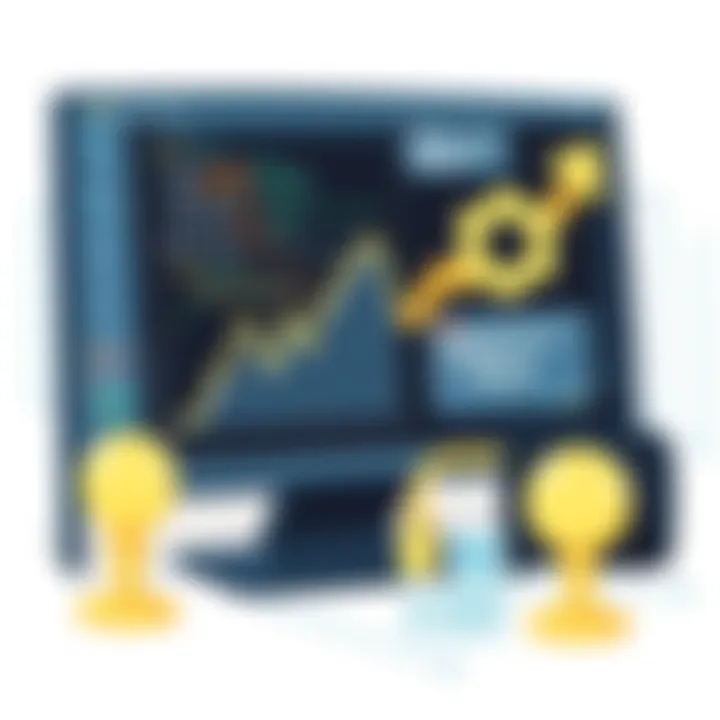Exploring Data Analysis and Forecasting Methods


Intro
In the era of big data, understanding how to analyze and forecast data effectively is no longer optional—it's a necessity. Organizations across various industries increasingly rely on data-driven insights to guide strategic decisions. As businesses navigate complex market landscapes, the tools and methodologies they employ for data analysis and forecasting have become pivotal.
This article aims to serve as a comprehensive guide, offering insights into the multifaceted world of data analysis and forecasting methods. We’ll dive into the essential techniques, explore their applications, dissect their limitations, and illuminate trends that are shaping the future of predictive analytics. We want to empower tech professionals, data scientists, and business leaders in harnessing data effectively and strategically, ensuring they have the know-how to capitalize on the wealth of information available.
The narrative will unfold in distinct sections, each designed to enrich your understanding of the domain. So, let's kick things off by woven through the intricate fabric of software development, cloud computing, and data analytics.
Understanding Data Analysis
Data analysis stands as a cornerstone in the realm of modern business and technology. In an era where data reigns supreme, understanding data analysis is not merely an option; it is an imperative for any professional looking to make informed decisions. The process of converting raw data into coherent insights allows organizations to navigate the complexities of the market landscape with greater ease.
Definition and Importance of Data Analysis
At its core, data analysis refers to the systematic examination and interpretation of data to derive useful information. It involves it digging beneath the surface of datasets, much like a miner sifting through earth to find precious gems. Not only does it help in identifying trends, patterns, and anomalies, but it also serves as a foundation for forecasting future scenarios based on historical data.
Understanding its importance means recognizing its role in minimizing risks and maximizing opportunities. Businesses equipped with robust data analysis capabilities can tailor their strategies to meet customer demands more efficiently, optimize operations, and ultimately boost their bottom line. In sum, data analysis is akin to having a compass in the ever-changing sea of market dynamics.
Types of Data: Structured vs. Unstructured
When embarking on the data analysis journey, one must first grasp the differences between structured and unstructured data.
- Structured Data is like a well-organized library, neatly catalogued and easily searchable. This data usually resides in relational databases, characterized by clear definitions and data types, such as numerical values or dates. Think of customer demographics collected via surveys or sales figures stored in Excel spreadsheets.
- Unstructured Data, on the other hand, resembles a cluttered attic, filled with various items that lack organization. This type includes text-heavy information such as emails, social media posts, or video files. The challenge lies in its analysis, as it does not fit neatly into predefined models. Nevertheless, unstructured data holds immense potential, often providing richer insights when analyzed effectively.
Role of Data in Decision Making
The role of data in decision-making processes cannot be overstated. It acts as an anchor in turbulent times, providing clarity and direction. Decision-makers can utilize data analysis to make informed choices that align with organizational goals. By relying on data, businesses can discard gut feelings that lead to flawed judgment, opting instead for a fact-based approach that fosters reliability and transparency.
To illustrate this:
- Strategic Planning: Firms can analyze historical performance data to predict future outcomes, guiding resource allocation and investment decisions.
- Customer Insights: Analyzing purchase behavior can help in personalizing marketing strategies and improving customer experiences.
"In God we trust; all others bring data."
— W. Edwards Deming
For further reading and resources on data analysis, consider visiting Wikipedia on Data Analysis or Britannica on Statistical Data.
Key Techniques in Data Analysis
In the vast realm of data analysis, having a solid grasp of key techniques is absolutely essential. These methods serve as the backbone for transforming raw data into insightful information, which informs decisions in various sectors. Mastering these techniques means not just skimming the surface; it involves delving deeper into what each method offers and how it can align with specific goals or challenges faced by organizations.
Data analysis can be likened to finding a needle in a haystack, where each technique plays a vital role in uncovering that valuable insight. From descriptive methods that help summarize past information to predictive analytics that give a glimpse into future happenings, each approach provides unique benefits and considerations. It's worthwhile for professionals, especially in technical fields, to understand the landscape of these techniques, as they can directly impact operational efficiency and strategic direction.
Descriptive Analysis
Descriptive analysis involves summarizing historical data to identify patterns or trends. It's akin to looking into a rearview mirror while driving—what’s behind you matters for making informed choices moving forward. This method is crucial because it provides a foundation upon which further analyses can be built.
A few common techniques here include:
- Measures of Central Tendency: Mean, median, and mode provide an overview of what is typical in your dataset.
- Data Visualization: Graphs and charts turn numbers into meaningful pictures, often revealing insights at a glance.
- Frequency Distributions: Understanding how data is spread can illuminate significant anomalies or trends.
“Descriptive analysis transforms complex datasets into understandable summaries, making it easier to grasp the bigger picture.”
Inferential Analysis
Inferential analysis takes a step beyond descriptive methods, allowing analysts to make predictions or generalizations about a larger population, based on a smaller sample. It’s like pulling out a few pieces of fruit from a basket and concluding what the entire basket contains. Understanding various statistical tests is crucial here.
The methods primarily utilized include:
- Hypothesis Testing: It helps in validating if a certain assumption about data holds true.
- Confidence Intervals: These give a range that’s likely to contain the population parameter, adding a layer of precision to conclusions drawn from sample data.
- Regression Analysis: An invaluable tool for understanding relationships between variables, effectively allowing you to predict outcomes based on input.
Exploratory Data Analysis (EDA)
Exploratory Data Analysis is often likened to detective work. Here, the goal is to explore data sets to find patterns, spot anomalies, and check assumptions. This technique is more about intuition and creativity rather than just statistical rigor.
Key components of EDA involve:
- Visual Methods: Scatter plots and box plots help uncover relationships or distributions.
- Correlation Analysis: Understanding how different variables relate to one another can yield valuable insights.
- Outlier Detection: Identifying and understanding the causes behind extraordinary data points can prevent misleading conclusions in future analyses.
Predictive Analysis
Predictive analysis is where the magic often happens, as it enables businesses to forecast trends based on patterns recognized in historical data. This is not just guesswork; it relies heavily on statistical algorithms and machine learning techniques.
To engage in predictive analysis, one may utilize:
- Time Series Forecasting: This method looks at sequential data points collected or recorded at specific time intervals. It is particularly useful for predicting future values based on past trends.
- Classification Techniques: These help in categorizing data into predefined classes based on input features.
- Regression Models: As previously mentioned, these are used to predict continuous outcomes.
Prescriptive Analysis
Having ventured through the land of what has happened and what might happen, prescriptive analysis takes the next leap—guiding actions based on findings. It doesn’t just tell you that a trend exists; it tells you what to do about it.
Elements of prescriptive analysis include:
- Optimization Models: Factors in constraints and helps in making decisions that yield optimal solutions.
- Scenario Analysis: Testing different scenarios to understand their potential impacts allows companies to prepare for uncertainty.
- Simulation Techniques: These are vital for modeling real-world processes to evaluate performance under various conditions.
Adapting these techniques equips data professionals with a reliable toolkit for transforming raw information into actionable strategies, helping navigate the tumultuous waters of modern data-driven business environments. Being insightful when wielding these methods can indeed deliver significant advantages in making effective decisions.


Forecasting Methods: An Overview
Forecasting methods play a pivotal role in the landscape of data analysis. Their primary significance lies in their ability to provide insights into future trends based on historical data. The capacity to anticipate what lies ahead enables organizations to strategize effectively, mitigating risks and capitalizing on opportunities. When businesses lean into accurate forecasting, they are not just guessing; they are harnessing data patterns to make informed decisions.
In this section, we will cover:
- Definition and Goals of Forecasting
- Difference Between Forecasting and Prediction
- Common Use Cases for Forecasting
Each subsection will build a framework that helps demystify the various elements associated with forecasting methods. Understanding these can help guide tech professionals and data scientists as they navigate the often nuanced convergence of analytics and decision-making.
Definition and Goals of Forecasting
Forecasting is the process of making predictions about future events based on historical data and analysis. This definition, while straightforward, encapsulates a world of complexity. The goals of forecasting are manifold and tailored to meet diverse industry needs. At its essence, forecasting aspires to:
- Anticipate Future Trends: This means understanding potential changes in demand, supply, and other key factors.
- Support Strategic Planning: Reliable forecasts help businesses formulate effective strategies that align with market dynamics.
- Improve Resource Allocation: By predicting needs accurately, organizations can allocate resources more efficiently, thus minimizing waste and optimizing operations.
Forecasting embraces statistical techniques, analytical methods, and even expert judgment in the service of these goals, illustrating its dynamic nature across varying sectors.
Difference Between Forecasting and Prediction
While often used interchangeably, there are subtle differences between forecasting and prediction. Understanding these distinctions can enhance clarity in discussions surrounding data analytics.
- Forecasting is generally more structured and driven by historical data analyses. It usually comes with quantifiable measures of accuracy and uncertainty, helping stakeholders gauge trust in the results.
- Prediction, on the other hand, can refer to any assertion about the future, whether based on data or not. It may rely on intuition, experience, or even trends observed in the moment, often lacking the rigorous methodology of forecasting.
Think of it this way: forecasting aims for precision and reliability, while prediction could be seen as a broader, looser approximation. In a world that favors evidence-based insights, understanding where one method ends and the other begins can be crucial.
Common Use Cases for Forecasting
Forecasting methods have diverse applications across numerous fields. Some prevalent use cases include:
- Supply Chain Management: Accurately predicting inventory requirements can save costs and streamline operations.
- Financial Planning: Businesses utilize forecasting to project revenues and expenditures, crucial for budgeting and investment decisions.
- Healthcare: Predictive analysis can help anticipate patient influx and resource requirements in hospitals.
- Consumer Behavior: Companies analyze trends to refine marketing strategies and tailor offerings to customer preferences.
Each use case illustrates the nuance and practicality of forecasting, revealing how essential these methods are to informed decision-making in a variety of sectors.
"Forecasting is not just about predicting what will happen, but also preparing for the thousand potential outcomes that may arise."
Quantitative Forecasting Techniques
Quantitative forecasting techniques play a pivotal role in aiding organizations to make data-driven decisions with precision and confidence. By relying on numerical data and historical time series, these techniques enable businesses to predict future trends and patterns with a level of accuracy that qualitative methods often cannot provide. In a landscape where data is increasingly abundant, leveraging quantitative methods allows professionals not just to react but to anticipate market changes and drive strategic planning effectively.
Time Series Analysis
Time series analysis is a cornerstone of quantitative forecasting. It involves collecting data points over a period of time to identify underlying patterns such as trends, seasonal variations, and cyclical movements. This technique is particularly useful for industries where historical data is plentiful.
- Benefits: Time series analysis helps in producing forecasts that can guide inventory management, workforce planning, and budgeting.
- Considerations: Seasonality must be understood and accounted for to avoid misinterpretations. For example, if a company sees sales spike around holidays, ignoring this data when forecasting for January can lead to misguided business strategies.
To illustrate, a coffee shop can use time series analysis of its sales data over the past few years to predict customer traffic during the summer months. This way, they can optimize staff scheduling and inventory.
Regression Analysis
Regression analysis is another critical quantitative forecasting technique. It investigates relationships among variables and helps to determine how the change in one or more independent variables impacts a dependent variable. Simply put, it finds the line of best fit through data points to help firms make informed predictions about future outcomes.
- Benefits: By applying regression analysis, organizations can identify key predictors of their performance. This insight helps them focus resources on the most impactful areas.
- Considerations: Ensuring the variables chosen are relevant is vital. Otherwise, predictions can lead astray. For instance, if a retail store assumes that merely increasing marketing spend will boost sales without accounting for consumer trends, their forecasts may not materialize as expected.
Consider a real estate developer forecasting property prices based on features like square footage, location, and market trends. By employing regression analysis, they can estimate which features contribute most to pricing, ultimately guiding investment decisions.
ARIMA Models
ARIMA (AutoRegressive Integrated Moving Average) models are powerful tools for time series forecasting, integrating aspects of both autoregression and moving averages. This technique is suited for datasets that show clear trends over time.
- Benefits: ARIMA models can adapt to various data patterns, making them versatile for different forecasting needs.
- Considerations: Selecting the right parameters for an ARIMA model can be complex and involve more advanced statistical knowledge. Failing to optimize these settings can reduce accuracy.
For example, a financial analyst might use ARIMA to forecast stock prices based on historical data. This technique allows them to predict future prices incorporating seasonality and trends, important for making investments.
"Quantitative forecasting techniques transform data points into actionable insights, turning numbers into narratives that drive business strategy."
In summary, quantitative forecasting techniques—time series analysis, regression analysis, and ARIMA models—form the bedrock of data-driven decisions in numerous industries. Understanding these tools allows professionals to harness data effectively, paving the way for strategic advancements in their respective fields. As the landscape of data continues to evolve, adopting these quantitative methods becomes not just beneficial but essential for sustainable growth.
Qualitative Forecasting Techniques
Qualitative forecasting techniques play a pivotal role in understanding market dynamics that can't always be quantified. Unlike their quantitative counterparts, qualitative methods leverage insights from human intuition, experience, and personal judgment. This approach becomes essential when historical data is insufficient, unreliable, or nonexistent. Moreover, these techniques are particularly beneficial in industries where consumer preferences fluctuate, such as fashion, food, and technology.
The essence of qualitative forecasting lies in its adaptability. It provides agility in responding to changing market conditions. For instance, if a new trend emerges in the fashion world, qualitative methods can help businesses gauge public reaction faster than the often-slow quantitative analyses.
Market Research Methods
Market research methods constitute a cornerstone of qualitative forecasting. They encompass diverse strategies aimed at gathering consumer insights. Techniques might include surveys, polls, and observational studies. By directly engaging target demographics, companies can extract valuable feedback about trends and product preferences.
For example, a company launching a new beverage might conduct taste tests among specific age groups to ascertain which flavors resonate most. This direct feedback can be instrumental in refining product offerings before the launch.
- Surveys: These can be conducted online or offline, often using structured questionnaires to capture consumer sentiments.
- Interviews: Conducting one-on-one discussions can help peel back layers and understand motivations.
- Observational Studies: Watching how consumers interact with products in real-world settings provides context that numbers alone cannot.
Delphi Method
The Delphi method is an eminent qualitative forecasting technique, especially for forward-thinking scenarios. Originally developed for predicting technological advancements, it involves a panel of experts who anonymously reply to questions in several rounds. After each round, a facilitator provides a summary of the panel's forecasts and reasons. This process continues until a consensus emerges.
The strength of the Delphi method lies in its structured feedback mechanism, reducing cognitive biases that can skew individual opinions. Businesses in diverse sectors, from healthcare to technology, can benefit from this approach by harnessing expert insights to craft future strategies and innovations.


The Delphi method is not just about gathering opinions but refining them through iterative feedback until clarity surfaces.
Focus Groups and Interviews
Focus groups and interviews are practical approaches within qualitative forecasting that drill down into consumer psyche. Focus groups typically consist of a small number of participants led by a facilitator. These discussions can explore attitudes, feelings, and perceptions related to a particular product or concept. Interviews, on the other hand, offer a more in-depth exploration into individual thoughts and can uncork insights not revealed in group settings.
Utilizing diverse participants can yield rich data. For instance, during the development of a new smartphone, a company might conduct focus groups comprising tech-savvy users, casual phone users, and industry analysts. By exploring varying perspectives, they can pinpoint features that appeal across demographics.
- Flexibility: Both methods allow for adaptation based on emerging discussions.
- Depth of Insight: They can uncover underlying motivations and emotional drivers behind consumer choices.
- Broad Applicability: These techniques are effective for testing marketing strategies, new product ideas, and advertising campaigns.
In essence, qualitative forecasting techniques equip organizations with a lens into the unpredictable consumer mind. Utilizing methods like market research, the Delphi method, and focus groups grants businesses the necessary insights to navigate fluid markets and make informed decisions.
Machine Learning in Data Analysis and Forecasting
Machine learning has emerged as a key player in the realm of data analysis and forecasting. Its capabilities extend beyond traditional statistical methods, offering a means to tackle complex datasets that often present more questions than answers. By leveraging algorithms that learn from data, businesses can uncover patterns and make predictions with an accuracy that was once unimaginable. This section aims to unpack the significance of machine learning in these fields, exploring essential techniques, advantages, and considerations.
Prelims to Machine Learning Techniques
When you boil it down, machine learning is about teaching computers to recognize patterns without explicit programming instructions. Think of it as training a dog to fetch; instead of writing out step-by-step commands, you reward the dog when it performs the desired action, eventually leading it to learn through experience.
In data analysis and forecasting, machine learning plays various roles:
- Automation of data processing: Rather than manually sorting through data, machine learning can sift through terabytes of information, identifying trends and anomalies much faster.
- Improving predictive accuracy: By learning from past data, machine learning models can develop insights that improve forecasting outcomes.
- Adapting to new data: Unlike traditional systems, once trained, machine learning systems can adapt to changes in incoming data, refining their predictions.
These elements underline why machine learning is no longer a luxury but a necessity for organizations wishing to harness the full potential of their data.
Supervised vs. Unsupervised Learning
Diving deeper, machine learning fundamentally splits into two major categories: supervised and unsupervised learning, each serving different purposes.
Supervised Learning
In supervised learning, models are trained on labeled datasets, meaning that the input data is paired with the correct output. For instance, if a model is tasked with predicting house prices, it learns from historical sales data where both the features (like size and location) and the target output (sale price) are known. Once trained, these models can predict outcomes for new, unseen data. Examples include:
- Regression Analysis: Used for predicting continuous outcomes (like price or sales volume).
- Classification: Applied when the outcome variable is categorical (like whether an email is spam or not).
Unsupervised Learning
On the flip side, unsupervised learning deals with datasets that don’t have labeled responses. Here, the algorithm attempts to find patterns or groupings without prior knowledge of outcomes. For example, clustering algorithms can group customers based on purchasing behavior without knowing beforehand what defines a group. Key considerations in this space:
- Dimensionality Reduction: Techniques like PCA (Principal Component Analysis) help simplify large datasets, making them easier to visualize and analyze.
- Anomaly Detection: Identifying rare items or events, such as fraudulent transactions in banking.
Deep Learning Approaches
No discussion of machine learning would be complete without touching upon deep learning. This subset of machine learning is inspired by the human brain’s structure and function—using layers of artificial neural networks. It excels in processing vast amounts of unstructured data such as images, audio, and text.
Key Characteristics of Deep Learning:
- Layered Structures: Models are built with multiple layers that allow for the processing of high-dimensional data.
- Feature Extraction: Unlike traditional algorithms that require feature selection, deep learning automatically identifies the features relevant to the task at hand.
- Advanced Applications: Commonly used in fields such as computer vision, natural language processing, and even game playing, significantly outpacing traditional methods in areas like image recognition.
Incorporating deep learning into data analysis not only enhances the depth of insight generated but also opens doors to limitless possibilities in forecasting.
In summary, machine learning marks a transformational shift in the way data analysis and forecasting are approached. By combining supervised and unsupervised learning techniques with the power of deep learning, organizations can unlock new potential within their data, ultimately driving more informed decision-making.
To explore more about the complexities of machine learning, consider visiting renowned resources like Wikipedia or academic publications from Google Scholar.
Data Visualization Techniques
Data visualization stands as a pivotal component in both data analysis and forecasting for various reasons. In a world increasingly driven by data, the ability to convey complex information in an easily digestible manner becomes invaluable. Effective visualization not only enhances comprehension but also aids in identifying patterns, trends, and anomalies within the data. This section examines the significance of data visualization, popular tools available, and best practices to ensure clarity and precision.
Importance of Data Visualization
The importance of data visualization cannot be overstated. At its core, visualization translates raw data into a form that is understandable for stakeholders at different levels.
- Cognition: Our brains are wired to process visuals more readily than text or numerical data. Infographics and charts facilitate quicker understanding and retention of information.
- Communication: Well-crafted visualizations act as a universal language, bridging gaps between technical and non-technical audiences. A single graph can convey years of research more effectively than a report filled with technical jargon.
- Insight Discovery: Visualization enables analysts to spot trends and outliers that might go unnoticed in rows of numbers. This leap from data to actionable insight can transform decision-making processes in real-time.
- Efficiency: Incorporating visuals into reports can streamline presentations, making data exploration faster. An interactive dashboard, for instance, allows users to drill down into specifics without sifting through endless datasets.
In the realm of forecasting, visualization can highlight potential future trends based on past data, making it crucial for businesses aiming to anticipate changes in the market.
Common Visualization Tools
A variety of tools are at the disposal of data practitioners, each bringing unique features and capabilities. Here are a few commonly used visualization tools:
- Tableau: Known for its user-friendly interface, Tableau allows for the creation of stunning interactive visuals. Its drag-and-drop functions make it accessible for beginners and sophisticated enough for experienced analysts.
- Power BI: A Microsoft product, Power BI integrates smoothly with other Microsoft products and offers a compelling suite for business analytics.
- Python Libraries (Matplotlib, Seaborn): For those comfortable with coding, Python’s libraries provide extensive customization options, allowing for tailored visualizations according to specific project needs.
- D3.js: This JavaScript library offers incredible flexibility and control over SVG elements, making it a favorite for web-based applications.
Data visualization tools are not just for developers; even business analysts can use them to create informative dashboards that bridge the gap between data and user experience.
Best Practices in Data Visualization
Creating effective visuals requires more than just software skills. Here are some best practices to follow:
- Know Your Audience: Tailor your visuals to your audience's level of expertise. A different approach is needed for laypersons compared to data scientists.
- Choose the Right Type of Visualization: Different data types call for different visualizations. For instance, line graphs work well for time series data, while bar charts can effectively compare categories.
- Keep It Simple: Avoid clutter. Overly complex visuals can confuse rather than clarify. Aim for clarity and simplicity to boost comprehension.
- Use Color Wisely: Colors can express emotions and draw attention. However, using too many colors can distract viewers. Stick to a consistent palette that aligns with your theme.
- Label Clearly: Ensure that all axes, legends, and headers are correctly labeled and easy to read. Clear captions and annotations help convey the data story more effectively.
"Good visualization is not just about the visuals, it's about turning data into stories."
In summary, successful data visualization is an art and a science. By utilizing the right tools, adhering to best practices, and understanding the audience, businesses can leverage data more effectively to inform their decisions and forecasts, navigating towards a data-driven future.


Challenges in Data Analysis and Forecasting
Understanding the hurdles faced in data analysis and forecasting is instrumental in maximizing the accuracy and efficacy of these processes. As businesses increasingly rely on data-driven strategies, it becomes essential to help navigate the myriad of challenges that can emerge. This section will dissect key challenges like data quality issues, handling missing data, and the perils of overfitting and underfitting in predictive models. Tackling these issues head-on not only sharpens analytical capabilities but also enhances the integrity of insights derived from data, a fundamental asset in today’s competitive landscape.
Data Quality Issues
Data quality stands as a cornerstone of effective data analysis. Poor quality data can lead to decisions based on incorrect insights that might prove detrimental. Issues regarding accuracy, consistency, and completeness must be addressed rigorously.
Importance of Data Accuracy
A glaring example of data quality issues comes to light in the world of healthcare analytics. If a hospital uses patient records that contain errors—say, incorrect medication doses—this not only affects treatment plans but can have life-threatening consequences. Ensuring high data quality can be the difference between success and failure.
Strategies for Improvement
- Regular Audits: Frequent checks on data sources to identify anomalies or inaccuracies.
- Validation Processes: Implement systems that confirm the accuracy of incoming data.
- Employee Training: Teaching staff about data entry best practices to minimize errors.
In the end, quality should never be sacrificed for quantity.
Handling Missing Data
Missing data is a frequent annoyance that can skew your analysis if not handled appropriately. It's akin to trying to solve a puzzle with missing pieces; it might be doable but won't yield the full picture.
Impact of Missing Data
Ignoring missing data can lead to biases. For instance, if survey data excludes responses from a particular demographic, the findings might misrepresent the broader population. Thus, understanding how to manage missing data becomes crucial.
Techniques for Addressing Missing Data
- Imputation Techniques: Filling in missing values based on the mean, median, or mode.
- Using Algorithms: Certain machine learning techniques can handle missing data naturally, such as decision trees.
- Complete Case Analysis: Only including cases without missing data, though this can lead to loss of valuable information.
Choosing the right approach depends on the context and nature of the data.
Overfitting and Underfitting in Models
Overfitting and underfitting are common pitfalls in modeling that can severely compromise predictive accuracy. Overfitting happens when a model becomes too complex, capturing noise rather than the actual pattern.
Consequences of Overfitting
For example, if a retail company uses a model that perfectly predicts sales based on highly specific historical data, it may struggle in real-world scenarios where variables fluctuate. Conversely, underfitting occurs when a model is too simplistic, failing to capture important patterns.
Strategies to Combat Overfitting and Underfitting
- Cross-Validation: Split the dataset into multiple subsets to validate the model's performance on unseen data.
- Regularization Techniques: Apply methods like Lasso or Ridge regression to prevent overfitting by penalizing excessive complexity in the model.
- Feature Selection: Identify the most relevant variables to prevent models from being overly complex or too simplistic.
Striking a balance between these aspects is key to developing robust predictive models that can withstand the tests of time and variability.
Addressing these challenges effectively not only enhances the accuracy of predictions but also builds trust in data-driven decisions within organizations.
In summary, tackling the challenges in data analysis and forecasting is not a one-size-fits-all scenario. Some methods may work wonders in one context but fall flat in another. Continuous learning, adapting, and refining approaches is what truly leads to data mastery.
The Future of Data Analysis and Forecasting
The landscape of data analysis and forecasting is rapidly changing, influenced by advances in technology, increasing amounts of data, and evolving consumer expectations. Recognizing the importance of these changes is crucial for businesses aiming to maintain a competitive edge. This section will discuss emerging trends, the potential evolution of machine learning algorithms, and ethical considerations in data usage, emphasizing the significance of these elements in informing effective strategies for the future.
Trends in Data Analytics
Data analytics is not a static field. New trends emerge with each passing year, reshaping how organizations analyze and interpret data. Some of the most notable trends today include:
- Real-time Analytics: The ability to analyze data as it comes in is becoming increasingly important, particularly for industries like finance and e-commerce where timely information is crucial.
- Augmented Analytics: Combining machine learning and natural language processing, this trend aims to automate data preparation and enable users to glean insights without needing extensive technical skills. It empowers employees at all levels to make data-driven decisions.
- Self-service BI Tools: Businesses are moving towards equipping their teams with user-friendly data visualization tools that allow non-technical users to derive insights from data without heavy reliance on IT departments.
- Data Democratization: This trend centers on making data accessible to all employees, fostering a culture of data literacy throughout an organization. The aim is that everyone from marketing to operations can leverage data effectively.
These trends are not just trends; they represent the future of how data will be managed and utilized to drive decision-making.
Future of Machine Learning Algorithms
As computing power continues to grow and the availability of data expands, machine learning algorithms are expected to become more sophisticated. Future developments might include:
- Enhanced Learning Models: Algorithms that learn from smaller data sets will gain traction. This is particularly crucial in fields like healthcare, where obtaining large datasets can be challenging and expensive.
- AutoML (Automated Machine Learning): The simplification of building and deploying machine learning models will enable more individuals, regardless of their statistical knowledge, to create models, thus expanding the pool of data scientists.
- Federated Learning: This approach allows models to be trained across various devices while maintaining the privacy of the data. It will be especially relevant in industries handling sensitive information.
By focusing on these advancements, businesses can capitalize on the predictive power of machine learning, making their forecasting methods even more robust and responsive to emerging trends.
Ethical Considerations in Data Usage
As we look to the future, ethical considerations surrounding data analysis and forecasting cannot be overlooked. Key issues include:
- Data Privacy: As regulations like GDPR take hold, businesses must find the balance between utilizing data effectively and respecting consumer privacy. This delicate equilibrium is essential for maintaining consumer trust.
- Bias in Data: Algorithms can only be as fair and effective as the data they are trained on. It is vital to recognize and mitigate biases, ensuring that the outcomes derived from data analysis reflect reality.
- Transparency: Organizations should take steps to ensure their data practices are transparent. Consumers increasingly want to know how their data is being used, and ethical transparency can bolster trust and engagement.
Moving forward, a conscientious approach to data usage will not only lead to better business practices but will also enhance the overall integrity of the data science field.
"With great power comes great responsibility." This adage holds true as we navigate the complexities of data analysis and forecasting in the future.
In summary, diving deep into the future of data analysis and forecasting is crucial for businesses looking to thrive in a data-driven world. Embracing trends, enhancing machine learning capabilities, and prioritizing ethical data practices will be pivotal for success.
Ending
In the realm of data analysis and forecasting, the conclusion serves as a vital distillation of all the insights gathered throughout the exploration of various methodologies. It is not simply an endnote; rather, it serves to reaffirm the significance of shaping clear and actionable decisions based on data-driven insights. With the rising complexities of modern data, understanding the nuances of these analyses becomes indispensable for professionals across various fields.
One of the key elements highlighted is the overarching necessity for precision in data handling and interpretation. Having robust analytical methods and incorporating predictive aanalytics push boundaries, allowing organizations to anticipate future trends effectively instead of just reacting to them. The benefits of implementing sound forecasting methods range from sustained business growth to improved operational efficiency. Each aspect discussed throughout this article emphasizes that with tumultuous market dynamics, the ability to swiftly adapt and make informed decisions could very well be the difference between flourishing and floundering in today’s competitive landscape.
Moreover, considerations around the ethical implications of data usage cannot be understated. The integrations of AI and machine learning, while providing unparalleled opportunities for analysis, also necessitate a cautious approach towards data privacy and bias. Therefore, developing a culture within industries that values ethical data practices is crucial to maintain trust and credibility with stakeholders, clients, and consumers alike.
"In the vast ocean of data, the sailors armed with knowledge will surely navigate through the storms of uncertainty."
Ultimately, a solid grasp of data analysis and forecasting methods not just enhances individual capabilities, but collectively uplifts entire organizations. Navigating through the sea of data, professionals can identify patterns, optimize processes, and ultimately achieve strategic goals.



